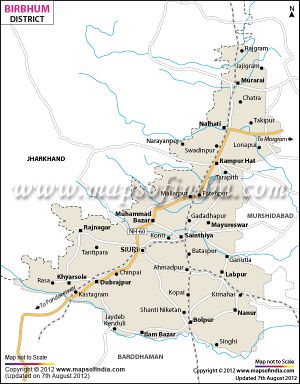Nanur
| Author:Laxman Burdak, IFS (R) |

Nanur (नन्नूर) is a village in Bolpur subdivision of Birbhum district in West Bengal. Nanoor is the birthplace of 14th century lyric poet Chandidas of Vaishnava Padavali fame.[1][2]
Location
Nanoor is 47 km from Suri, 18 km from Bolpur/Santiniketan and 29 km from Ahmedpur.Nanoor is located at 23.70°N 87.86°E. It has an average elevation of 24 metres (79 ft).
Variants
- Nannura (नन्नूर) (जिला वीरभूम, प. बंगाल) (AS, p.478)
- Nanoor
- Chandidas Nanoor
History
Archaeological finds: The archaeological department of Calcutta University organised an excavation programme in Nanoor in 1932 and 1957 but nothing much has happened since then.[3] The archaeological discoveries at Jalundi village in Nanoor block in 2007 are believed to be the ruins of the ancient Pala or Sen dynasties.[4]
Chandidas: According to the historian Binoy Ghosh, there were atleast three poets associated with the name of Chandidas. They were identified as ‘Baru’, ‘Dwija’ and ‘Din’. Baru Chandidas possibly belonged to Chhatna in Bankura district and he composed Srikrishnakirtan. Not much is known about Din Chandidas, except that he also composed on the life of Sri Krishna. Dwija Chandidas possibly belonged to Nanoor and composed lyrically rich creations initiating the finest traditions of Bengali padavali (gathering of songs). The Nanoor-Kirnahar area is full of folk-myths about Chandidas – the story of his love for a washer woman, the story of his religious devotion and music and the story of his death.[5]
The temple of Bisalakhi or Bagisree (more popular as Basuli) is believed to have been the centre of the devotional activity of Chandidas. The place at Nanoor where the Basuli temple (see pic lower down on this page) now stands and the surrounding area resembling a mound is called Chandibhita. An effort was made by the University of Calcutta to understand what is there in the mound by excavating a small section of it. In the “Excavations at Nanoor by K.G.Goswami, March 1950”, the report says that in the mound, with a radius of around 550 feet and height of 17 feet, there are five occupational levels. The lowest of these levels belong to the Gupta era. At another place in Nanoor, some coins of the Gupta era were recovered. During and prior to the Gupta era, Buddhism had a strong hold over Bengal and early tantric practices prevailed.[6]
Chandidas lived about 500 years ago, just around or a little prior to the arrival of Muslims in Bengal. By then the poet Jaydeva had already composed the Gita Govinda (see map below for location of Jayadev Kenduli). It is natural that such an age could produce a tantric devoted to his goddess, who could indulge in composing Sahajiya lyrics and propagate the merits of humanism. His compositions were a possible source of inspiration for Sri Chaitanya (1486-1534).[7]
There are claims that Chandidas originally belonged to Ketugram, in neighbouring Purba Bardhaman district, and later came to Nanoor.
नन्नूर
विजयेन्द्र कुमार माथुर[8] ने लेख किया है ...नन्नूर (AS, p.478) वीरभूम, पश्चिम बंगाल में स्थित है। 15वीं शती में बंगाल के प्रसिद्ध कवि चंडीदास का जन्म इसी स्थान पर हुआ था। चंडीदास और रामी की प्रेम कहानी का भारत की प्राचीन प्रेम कथाओं में विशेष स्थान है। अपनी कविताएँ चंडीदास ने यद्यपि 15वीं शती में लिखी थीं तो भी वह मानवीय गुणों से संपन्न हैं और उसका दृष्टिकोण आधुनिक सा जान पड़ता है- साबार ऊपर मानुष भाई ताहार ऊपर नाँई' अर्थात् "सबके ऊपर मानव है और उसके ऊपर कुछ नहीं।" यह चंडीदास की ही अमर सूक्ति है।
External links
References
- ↑ http://birbhum.gov.in/birtour2.htm
- ↑ "Nanoor". india9.com.
- ↑ "Birbhum archaeological sites face extinction". The Statesman, 29 June 2002.
- ↑ "Archaeological find at Nanoor". The Statesman, 10 February 2007.
- ↑ Ghosh, Binoy, Paschim Banger Sanskriti, (in Bengali), part I, 1976 edition, pages 261-266, Prakash Bhaban, Kolkata
- ↑ Ghosh, Binoy, Paschim Banger Sanskriti, (in Bengali), part I, 1976 edition, pages 261-266, Prakash Bhaban, Kolkata
- ↑ Ghosh, Binoy, Paschim Banger Sanskriti, (in Bengali), part I, 1976 edition, pages 261-266, Prakash Bhaban, Kolkata
- ↑ Aitihasik Sthanavali by Vijayendra Kumar Mathur, p.478